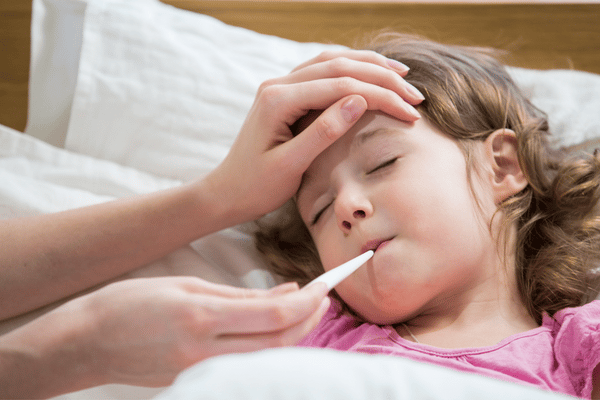Are you anxious about your sick child, and run ragged from going from store to store to store to store only to find empty shelves where you hoped to find children’s acetaminophen (Tylenol) and ibuprofen (Motrin or Advil)? What is a parent with a sick child supposed to do?
When our kids are sick, we want to help them feel better. We worry about fever and the dangers of fever in children. And now we are stuck because of supply chain issues with the production of children’s and infant’s liquid preparations of the medications we use to treat fever.

Read it again: fevers in children are uncomfortable but are generally not dangerous.
Normal body temperature in children is about 98.6 degrees Fahrenheit. A “normal” fever in children can range from 100.4- 105 degrees Fahrenheit. Less commonly fevers go to 106 (normal thermometers go to about 105 degrees Fahrenheit and then usually read “high”.)
Fevers serve the purpose of activating the body’s immune response. They also may make the body less hospitable to germs. What does this mean? It means that fevers serve a purpose. Fevers help kids get better.
So, if you can’t get medicine to treat your child’s fever, it’s ok! There are important things you can do to ease their discomfort and even help lower fever in children.
1. The most effective form of fever control is evaporative heat loss.
What this means is that the age-old act of putting a damp washcloth on your child’s forehead actually works, as long as you tweak it a little. The goal here is to expose as much skin as possible and repeatedly wipe ALL the exposed skin with a slightly cool (tepid) wet washcloth. Let the area dry, and wipe again. This helps the body cool by evaporation without causing shivering which actually increases body temperature. Do not leave a wet washcloth in one area (like the forehead) but rather keep wiping down your child’s whole body and allowing evaporation to cool your child.
Do not bundle your feverish child up because they are feeling chilled due to their fever. Bundling prevents heat loss and makes your child’s fever higher.
2. Have your child drink plenty of room temperature or cold liquid that does not contain caffeine.
Fever causes you to have increased fluid needs and makes you more prone to dehydration. Room temperature or cool liquids also help bring down the body’s temperature.
3. And, if you are desperate and your child can’t sleep, you can see if they weigh enough to chew a children’s chewable medication or if they are large enough (by weight) to take an adult dose.
Please reference the chart that is linked here or talk to your pediatrician about this option.
An adult (REGULAR STRENGTH) tablet can be crushed and put in pudding, yogurt, apple sauce, or ice cream if the child is unable to swallow a pill, but weighs enough to take one. Do not ever give over the weight-based dose of any medication, most especially acetaminophen (Tylenol) which is dangerous in overdose.
DO NOT GIVE ANY FORM OF ASPIRIN, EVEN CHEWABLE BABY ASPIRIN, to infants or children with a fever. It has been linked to a dangerous condition called Reye Syndrome.

As an emergency physician, I’ve heard this worry from parents for decades. Because children generally have such good immune systems, they often mount very high fevers in response to infections.
The truth is that the height of the fever has nothing to do with the severity of the infection (that is, a 104-degree fever does not equal a more dangerous or worse infection than a 101-degree fever). In fact, our immune systems actually work better at higher temperatures which is why our bodies mount a fever response to begin with. Your body is better able to fight infection with a fever than without.
The only reason doctors worry about fever at all is because it means the body is fighting some sort of infection.
This could be a viral infection or, more rarely in healthy children, a bacterial infection.
Viral infections can not be treated with antibiotics. Treatment is mainly for comfort and symptom control. The infection will resolve on its own as long as the child doesn’t need respiratory support or intravenous hydration. Vaccination for COVID and flu as well as common childhood illness can decrease the likelihood that your child will have a serious infectious illness. But the common cold and RSV still have no vaccines and sadly, even your fully vaccinated child is likely to get sick with a fever during cold and flu season.
Bacterial infections do need to be treated with antibiotics and can be dangerous if not treated, but the danger is not from the fever. The danger is the infection. The fever is just a sign of the infection. Doctors are far more concerned with how your child looks and feels when their fever breaks than the height of the fever.

If this happens, and you can’t find medicine to treat your child’s fever, don’t freak out. Attempt hydration and evaporative cooling, and if your child is acting ok and eating and drinking, the fever does not need further treatment. If your child is having difficulty breathing, lethargy, is unable to drink, the fever has lasted more than 5 days, or if there are other concerning symptoms please do seek medical care.
Pin this post and be sure to follow Vermont Mom on Pinterest!










